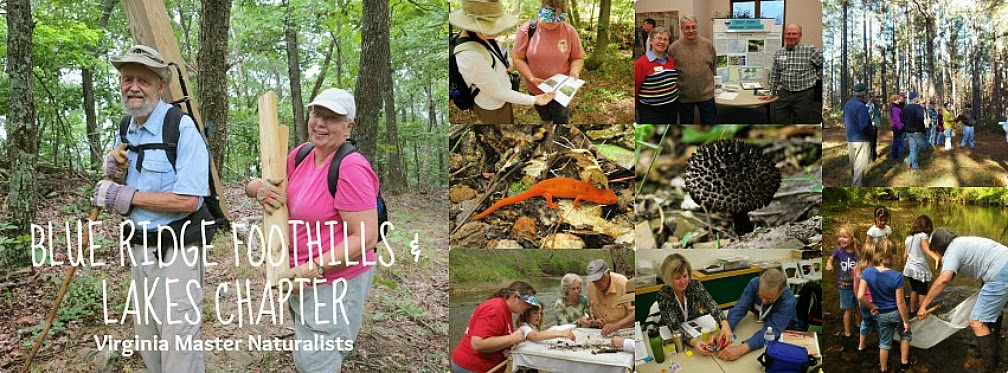

Where am I? Where was I? How do I get back? Are these questions you ever asked yourself when out hiking or biking in unfamiliar territory & terrain? Well I'm pretty sure many of us Master Naturalists have asked that question many times over.
In the "Olden Days" (a couple of years ago), we would generally rely on maps and a compass. But as
we all know, the current hip way is to use a GPS. Since a number of the folks in our Master Naturalist Chapter were not "fluent" in GPS we decided to get some expert advice and training. This training was graciously provided by two knowledgeable and friendly employees of the Smith Mountain Lake State Park.
Both Nate Clark (Assistant Manager of Smith Mountain Lake State Park) and Lauri Schular (Nature Interpreter of SML State Park) joined us at our Thursday Monthly BRFAL meeting of the Virginia Master Naturalists. They came well equipped with a PowerPoint presentation as well as a bevy of Garmin etrex handheld GPS units for some hands on instruction.
As you may know, GPS stands for Global Positioning System. The GPS system consists of 24 or so GPS satellites orbiting the globe. Each satellite orbits the earth twice per day. These satellites were placed in orbit by the US government, originally for military purposes, but now for all to use.
A handheld (or vehicular) GPS unit must track at least 3 satellites to get an accurate triangulated fix on your location. The GPS calculates the time for the satellite signal to reach the GPS for each satellite it "sees" and then accurately triangulates your location. Average accuracy is about 15 meters (~50 ft). When thinking of the distances to the satellites, this accuracy is simply remarkable.
In addition to learning the GPS basics, we also learned about map datums, latitude and longitude vs UTM (Universal Transverse Mercator) coordinates, true North vs magnetic North. If you wish to learn more about these things try Google or Wikipedia for more detail.
We also learned a little about mapping software which can provide topo maps for wherever you want and can be coordinated with your GPS. You can print out customized maps.
we all know, the current hip way is to use a GPS. Since a number of the folks in our Master Naturalist Chapter were not "fluent" in GPS we decided to get some expert advice and training. This training was graciously provided by two knowledgeable and friendly employees of the Smith Mountain Lake State Park.
Both Nate Clark (Assistant Manager of Smith Mountain Lake State Park) and Lauri Schular (Nature Interpreter of SML State Park) joined us at our Thursday Monthly BRFAL meeting of the Virginia Master Naturalists. They came well equipped with a PowerPoint presentation as well as a bevy of Garmin etrex handheld GPS units for some hands on instruction.
As you may know, GPS stands for Global Positioning System. The GPS system consists of 24 or so GPS satellites orbiting the globe. Each satellite orbits the earth twice per day. These satellites were placed in orbit by the US government, originally for military purposes, but now for all to use.
A handheld (or vehicular) GPS unit must track at least 3 satellites to get an accurate triangulated fix on your location. The GPS calculates the time for the satellite signal to reach the GPS for each satellite it "sees" and then accurately triangulates your location. Average accuracy is about 15 meters (~50 ft). When thinking of the distances to the satellites, this accuracy is simply remarkable.
Besides Master Naturalists, who uses GPS's? Well, airplanes, boats, cars, park rangers, police, emergency responders, surveyors, military, etc., etc. Virtually all new cell phones include GPS capability.
They advantages of GPS are manifold: accuracy, low cost, fun to use, etc. But be warned: if you are going into uncharted territory, be a good Scout and have a back-up means of navigating with you! Batteries can die, severe terrain can cause loss of signal to the GPS, you can drop it in the drink or on a big rock. So don't forget your old fashioned map and compass.
In addition to learning the GPS basics, we also learned about map datums, latitude and longitude vs UTM (Universal Transverse Mercator) coordinates, true North vs magnetic North. If you wish to learn more about these things try Google or Wikipedia for more detail.
We had some hands on fun with the Garmin etrex units. These device are low cost units (~$100) but we learned that they are just as accurate as units costing many times more. The more expensive units have more bells and whistles such as a larger monitor with color, paperless geocaching, etc.
We also learned a little about mapping software which can provide topo maps for wherever you want and can be coordinated with your GPS. You can print out customized maps.
Our training lasted about 1 hour, but to say the least we found it very informative. Our thanks goes out to Lauri & Nate for their valuable time spent with us!

No comments:
Post a Comment
Thanks for your comment and interest! NOW GO OUTSIDE!